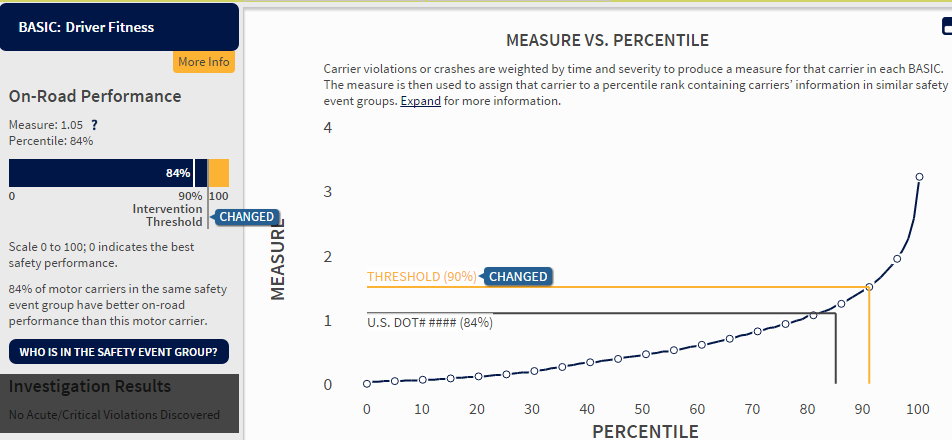
What the FMCSA Proposed Changes to CSA Safety Measurement System Website Actually Mean
posted in Blog by Brian Gray
What the FMCSA Proposed Changes to CSA Safety Measurement System Website Actually Mean
As first outlined in 2015, FMCSA announced on Oct 4th, 2016 that proposed enhancements to the Compliance, Safety, Accountability (CSA) Safety Measurement System (SMS) Website will be published in the Federal Register this week, to be followed by a 60-day public comment period.
These proposed enhancements are “a continuation of the Agency’s longstanding efforts to provide law enforcement, the motor carrier industry, and motor carriers with more informative safety data.” You can review these changes and provide comments by Dec 3, 2016. Click here to view proposed changes on SMS website.
It is important to note, no changes will be implemented in the public SMS Website display until AFTER completion of the National Academies of Sciences Correlation Study as required by the FAST Act.
FMCSA’s Goals for the Proposed Changes:
- Focus on carriers with high crash rates
- Focus investigative resources on carriers with more crash involvement
- Focus on carriers with recent violations
- More accurately account for carriers with increased exposure that drive on our roads the most
- Make it more effective at identifying carriers with HAZMAT compliance problems for interventions
- Make it easier to identify driver safety problems related to OOS
How the FMCSA will Meet their Goals: Six Proposed SMS Enhancements
1. Improving Our Focus on Carriers with High Crash Rates by Adjusting Intervention Thresholds
- Increasing Intervention Threshold for the Driver Fitness BASIC
- FMCSA will adjust the Intervention Threshold for the Driver Fitness BASIC from 80% to 90% to reflect its lower correlation to crash risk. This means FEWER carriers will be approached by the FMCSA for improvement.
- FMCSA will also adjust the passenger carrier threshold from 65% to 75% and the HAZMAT carrier threshold from 75% to 85%.


- Decreasing Intervention Threshold for the Vehicle Maintenance BASIC
- FMCSA will adjust the Intervention Threshold for the Vehicle Maintenance BASIC from 80% to 75% to reflect its higher correlation to crash risk. This means MORE carriers will be approached by the FMCSA for improvement.
- FMCSA will also adjust the passenger carrier threshold from 65% to 60% and the HAZMAT carrier threshold from 75% to 70%.


- Increase Intervention Threshold for the Controlled Substances/Alcohol BASIC
- FMCSA will adjust the Intervention Threshold for the Controlled Substances/Alcohol BASIC from 80% to 90% to reflect its lower correlation to crash risk. This means FEWER carriers will be approached by the FMCSA for improvement.
- FMCSA will also adjust the passenger carrier threshold from 65% to 75% and the HAZMAT carrier threshold from 75% to 85%.


2. Focusing Our Investigative Resources on Carriers with More Crash Involvement
FMCSA proposes an enhancement to the crash data sufficiency standards to focus investigative resources on carriers with more crash involvement. To do this, FMCSA will increase the number of crashes required to assign carriers a percentile in the Crash Indicator BASIC from two to three. Currently, FMCSA assign percentiles in this BASIC if carriers have had at least two reportable crashes in the past two years.
This means FEWER carriers will be approached by the FMCSA for improvement.


- Impact on Safety Event Group
- Increasing the number of crashes required for a percentile from two to three will impact some carriers’ safety event groups. This example carrier with two crashes will no longer have a percentile or safety event group. Other carriers may see a change in their safety event group, which may impact their percentiles.
3. Sharpening Our Focus on Carriers with Recent Violations
FMCSA proposes an enhancement to sharpen the focus on carriers with recent violations. FMCSA will simplify data sufficiency standards to only assign BASIC percentiles to carriers that have had an inspection with a violation in the past year. Currently, FMCSA assign percentiles in the Hours-of-Service Compliance, Vehicle Maintenance, Hazardous Materials Compliance, and Driver Fitness BASICs to carriers that meet the above requirement or have had their most recent inspection result in a violation.
This means, when NO violations are recorded within 12 months, the BASIC Percentile will read “No Violations In The Last Year.”


4. A More Accurate Picture of Carrier Exposure on Our Roads
FMCSA proposes an enhancement to the Utilization Factor to more accurately account for carriers with increased exposure that drive on our roads the most, also known as “high-utilization carriers”. FMCSA will expand the range over which the Utilization Factor is applied from 200,000 to 250,000 Vehicle Miles Travelled (VMT) per average Power Unit (PU). The Utilization Factor accounts for high-utilization carriers by adjusting their average PU values when calculating measures in the Unsafe Driving and Crash Indicator Behavior Analysis and Safety Improvement Categories.


5. A More Effective HM Compliance BASIC
FMCSA proposes an enhancement to the Hazardous Materials (HM) Compliance BASIC to make it more effective at identifying carriers with HAZMAT compliance problems for interventions. They will do this by:
- Segmenting Non-Cargo Tank and Cargo Tank Operations
- The HM Compliance BASIC will segment carriers by non-cargo tank and cargo tank operations because these operations often result in different violations. Segmenting these carriers will enable the SMS to account for these differences when assigning percentiles in this BASIC.
- Adjusting the Intervention Threshold
- FMCSA will adjust the HM Compliance BASIC’s Intervention Threshold from 80% to 90% to reflect its lower correlation to crash risk. This means FEWER carriers will be approached by the FMCSA for improvement.


6. More Effectively Identifying Driver Safety Problems Related to OOS
FMCSA proposes an enhancement to operating while out-of-service (OOS) violations to make it easier to identify driver safety problems related to OOS. FMCSA will move “Operating while Out-of-Service” violations that occurred in other BASICs to the Unsafe Driving BASIC. This change will consolidate driver safety problems that are currently spread across multiple BASICs.


- Impact of Moving “Operating While Out-of-Service” Violations on Original BASIC
- This change will also impact the BASICs in which these “operating while Out-of-Service” violations occurred. For example (below), the carrier had one of these violations moved from the HOS Compliance BASIC to the Unsafe Driving BASIC. As a result, here is the updated carrier’s measure and percentile in the HOS Compliance BASIC.









